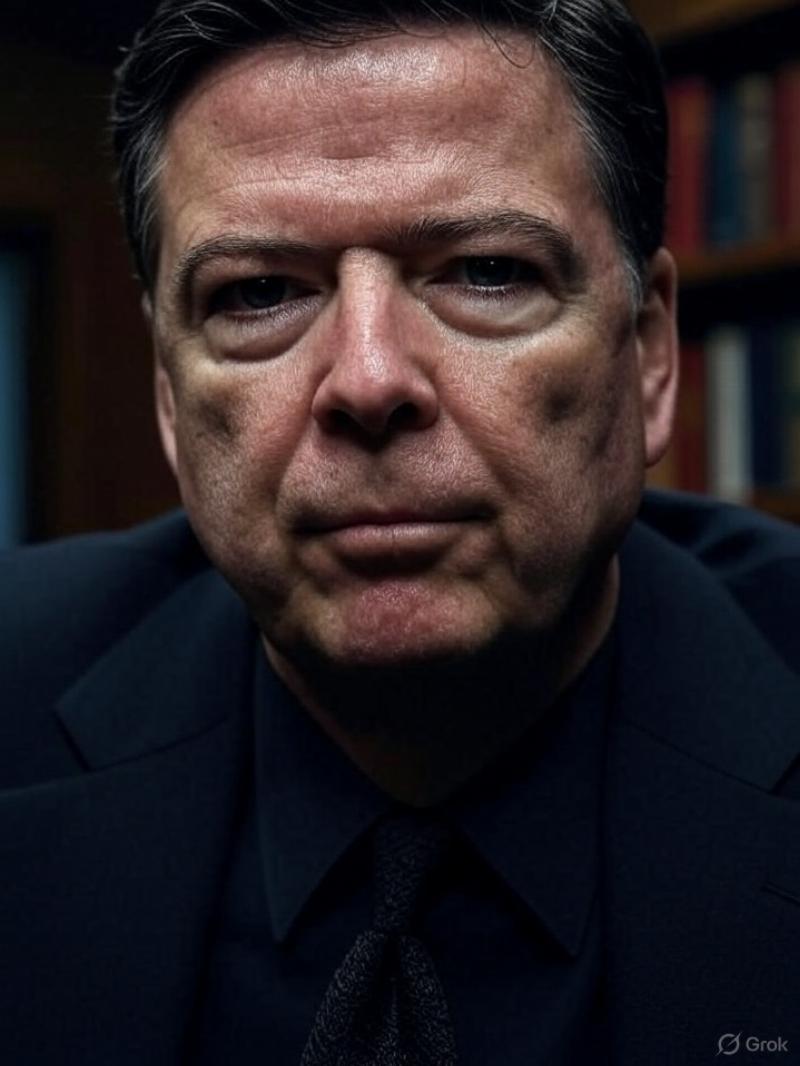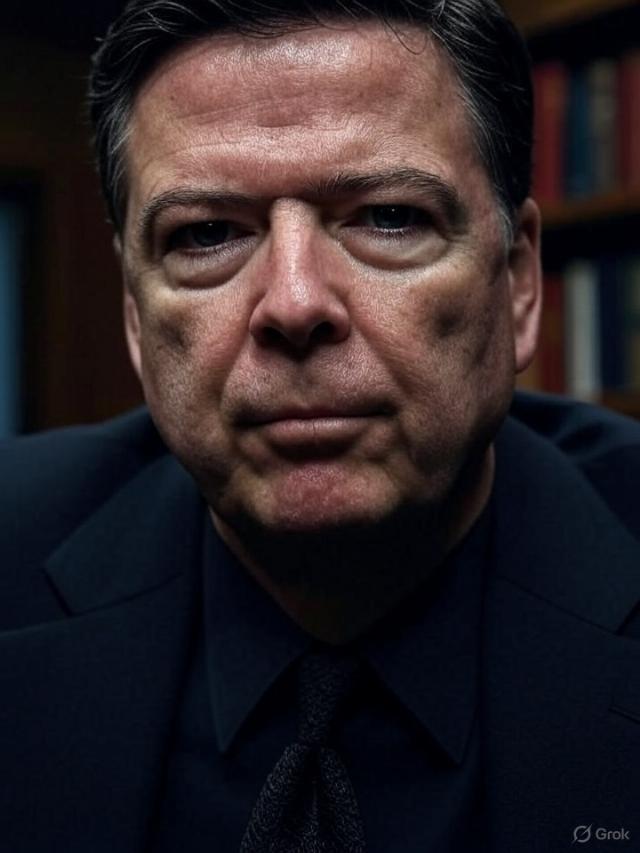


Donald Trump solidified his support each time he was wrongly indicted or impeached for transparent political motives, and, by the end of 2024, he was viewed by many as a downright folk hero. Unfortunately, and ironically, egomaniac James Comey, heretofore reduced to the irrelevance of “finding” anti-Trump beach pebbles, finds himself suddenly back in the limelight.
Discretion being the better part of valor, a graceful exit from the recent ill-starred indictment need be promptly executed, failing which President Trump will be responsible for canonizing a Hall of Fame creep.
A summary recounting of Comey’s career will reveal damning lowlights, a stark contrast with the thin gruel of his current indictment.
Comey first stepped into the limelight by trapping celebrity stylist Martha Stewart. Stewart had sold stock in a small pharma company, Imclone, whose key drug had failed a clinical trial, then unbeknownst to the broader market.
He and his agents led Stewart to believe that if she admitted to learning about the failure before selling, she was guilty of insider trading, while in fact she would not have been guilty. But by scaring her into lying, he had trapped his quarry and convicted Stewart of a false statement. The public to this day has the impression, created by this dishonest public servant, that Stewart had been unlawfully insider trading.
Soon after, he targeted famous Silicon Valley star financier Frank Quattrone for actions which Comey claimed were criminal but were not, thereby trapping Quattrone into a thinly predicated obstruction and tampering verdict, eventually overturned by the Appellate Court.
Comey’s third claim to national fame was what became known as the Plame Affair, leading to the conviction of VP Dick Cheney’s Deputy Lewis “Scooter” Libby.
In 2003, a former Ambassador to Gabon, Joseph Wilson, a minor State Department careerist, published an op-ed in the New York Times claiming that he, at the behest of Vice President Dick Cheney, had traveled to Niger to investigate whether Saddam Hussein’s regime had sought highly enriched “yellowcake” uranium, in turn, relevant to the case for war. Wilson claimed in this post-invasion article, seemingly falsely, that the evidence was negative (whereas the CIA interpreted his findings otherwise). This article helped the Left’s efforts to take down Bush, who had heroically galvanized a shaken and fearful post 9/11 country.
Immediately, the Bush Administration countered that, contrary to Wilson’s claim, Vice President Cheney had not sent him to Niger. In fact, it had been his CIA agent wife, Valerie Plame, whose CIA section engaged him. Nationally syndicated columnist Robert Novak reported this reaction, along with Plame’s name.
By way of formulaic bureaucratic retaliation, the CIA then sent a lukewarm criminal referral letter to the Department of Justice, claiming that Novak’s source had “outed” a CIA agent, claiming violation of the Foreign Agents Identification Act (“FAIA”).
As the Justice Department considered this referral, Comey, then Deputy Attorney General, persuaded his boss, John Ashcroft, to recuse himself on the theory that Ashcroft knew Bush confidant Karl Rove and Cheney’s Deputy Lewis “Scooter” Libby. The ethical Ashcroft complied without questioning whether Comey was similarly conflicted, and indeed this sneaky man earlier had a serious dustup with Rove and Libby at Ashcroft’s hospital bedside over renewal of the controversial Operation Stellar Wind. So, in fact, Comey had a clear and strong bias against both Rove and Libby, and as well was, it now appears, a stealth liberal anti-Bush Democrat.
Comey then, as Acting Attorney General, determined that a conflict existed, justifying a Special Counsel appointment. He quickly appointed a Chicago prosecutor, Patrick Fitzgerald, the godfather of Comey’s children and certainly not independent from Comey as he should have been.
Fitzgerald proceeded with his investigation, trapping both Libby and Rove into denials that they had leaked Plame’s name. Comey and Fitzgerald led the public falsely to believe that the FAIA law prohibited these targets from naming Plame to anyone, and that the FBI did not know who in fact had leaked her identity to Novak.
In fact there was no basis for a Special Counsel investigation because there was no crime, and, even if there were, the FBI knew who had leaked, one Richard Armitage. Moreover, Comey led the world to believe that Plame was an FAIA-protected agent, whereas in fact she was not, and leaking her name was not a crime.
Eventually, Libby was indicted and convicted for denying leaking, because he had leaked Plame’s identity to Judith Miller, a reporter who did not publish Plame’s name. Rove narrowly escaped. Comey not only gained fame from this devious misconduct, but also gained a valuable political scalp for his stealth liberal agenda, eventually leading to a good but highly distorted movie starring Naomi Watts and Sean Penn.
After entrapping Stewart, Libby, and Quattrone, Comey, as FBI Director, went to work to help Hillary Clinton avoid her criminal liabilities, which were substantial. He granted immunity to the aide who destroyed Clinton’s electronic devices containing 30,000 emails, which likely implicated her in serious corruption. But in granting that immunity, Comey did not require that the lower-level employee name his principal.
For those emails which the FBI had, Comey then persuaded Attorney General Loretta Lynch that his foreign intelligence made it impossible for Lynch to be the public face of the Clinton investigation. Comey then stepped into the limelight to claim responsibility for determining that Hillary should not be prosecuted for yet further misconduct regarding classified information on her private devices.
Comey relished the limelight as he detailed, bizarrely, why Hillary was seemingly guilty of mishandling classified information, but also why she should not be prosecuted. Clearly, Comey was egotistically stepping front and center to dramatically save Hillary, presumably to reap political rewards after her apparently certain election.
Having saved Hillary, Comey’s ego demanded that he dramatically announce the re-opening of the investigation after Clinton emails were found on disgraced Congressman Anthony Weiner’s laptop, probably costing Clinton the election.
Soon, Comey learned that someone had leaked to WikiLeaks various DNC emails showing that Hillary had rigged the Democrat primaries in her favor and against Bernie Sanders. She therefore sought to blame the leak on a “Russian hack,” which gave rise to the “Russian Collusion” hoax.
Comey could have examined this false claim of a “Russian hack” simply by having his technical aides examine the DNC server. However, he knew that the server would likely rule out a Russian hack and point to an internal leak, so he never asked the DNC for the server.
Along with CIA Director John Brennan, Comey sent in “Five Eyes” agents to plant the notion that the Russians had dirt on Hillary’s emails. Using this as a phony pretext, Comey initiated the Crossfire Hurricane investigation.
Comey’s agents did not tell the FISA court the whole truth, to wit, which was that the entire Russian hoax charge was a canard of the Clinton campaign. He thus obtained a series of FISA warrants, and, using the “two jump” rule, Comey was able to surveil the entire Trump campaign, including Trump Tower, electronically.
Unsuccessful in stopping Trump’s election, Comey then set about trapping both General Michael Flynn and young aide George Papadopoulos, using the same tricks he had used on Martha Stewart and Scooter Libby: making each feel that a truthful answer would lead the witness into jeopardy.
He then kept a book on Trump, hoping to goad him into an obstruction of justice or a false statement, by scaring the president about the Steele Dossier. He meticulously recorded his treacherous efforts in a series of memos, without telling the president he was so doing, or informing his superior of his efforts to gin up the Russian Collusion investigation, in spite of his duty to the Commander in Chief to report major counterintelligence projects.
These are just the lowlights of Comey’s recent career that reveal him as a master of trickery and duplicity, while posing as an honest law enforcement officer.
In light of all this, the current indictment of Comey comes nowhere near the level of manipulation and dishonesty characterizing this man’s career. The indictment is extremely weak and runs into clear precedent that Comey was not speaking falsely when he testified that he would “stand on” prior testimony, literally true, even if prior testimony were false.
Just as Trump was made a hero by fighting unfair charges, Trump, ironically, is resurrecting Comey from irrelevance and focusing on one of the few episodes in Comey’s recent career in which he was not actively enabling crimes. A massive conspiracy case involving Comey, John Brennan, James Clapper, and Hillary Clinton, for falsely distorting and concealing “Russiagate” information from Congress and FISC, extending to Brennan’s false 2023 Congressional testimony, would appear far more fitting, legally viable and socially informative.
While it is understandable that President Trump wishes for some form of accountability, perhaps even retribution, against Comey, there could be no worse way to achieve it than the instant absurdly vaporous prosecution, in which, ironically, he is weaponizing the law just as did his opponents. This prosecution will recast Comey in bronze as a hero, diverting attention from his gelatinous, societally poisonous maneuvers of over twenty years.
John D. O’Connor is a former federal prosecutor and the San Francisco attorney who represented W. Mark Felt during his revelation as Deep Throat in 2005. O’Connor is the author of the books, The Mysteries of Watergate: What Really Happened and Postgate: How the Washington Post Betrayed Deep Throat, Covered Up Watergate and Began Today’s Partisan Advocacy Journalism.

Image from Grok.
